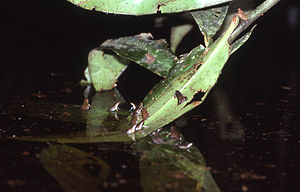Chiasmocleis ventrimaculata
The dotted humming frog (Chiasmocleis ventrimaculata) is a frog that lives in Ecuador, Brazil, Peru, and Bolivia. Scientists think it might live in Colombia too. Scientists have seen it between 0 and 400 meters above sea level. It is famous because it lives in the same holes in the ground with tarantula spiders.[3][2][4]
| Chiasmocleis ventrimaculata | |
|---|---|

| |
| Conservation status | |
| Scientific classification | |
| Kingdom: | Animalia |
| Phylum: | Chordata |
| Class: | Amphibia |
| Order: | Anura |
| Family: | Microhylidae |
| Family: | Gastrophryninae |
| Genus: | Chiasmocleis |
| Species: | C. ventrimaculata
|
| Binomial name | |
| Chiasmocleis ventrimaculata (Andersson, 1945)
| |

| |
| Synonyms[2] | |
| |
Appearance
The adult male frog is 20 to 23 mm long from nose to rear end. The adult female frog is 21 to 24 mm long. The skin on its back and sides is dark green or gray with gold and light blue spots. Its underside is yellow-white in color with big gray or brown spots. Its feet are not webbed. For a frog, it has short hind legs. For a frog, it has a narrow head and pointed nose.[4]
Home
This frog lives in tropical forests in the Amazon where there is water in the air, but people have also seen it in places where trees have been cut down and in other places where humans have changed the places where the frog could live. It spends most of its time on land instead of in the water like a swimming frog or up in the trees like a tree frog. People have found it hiding in the dead leaves on the ground. It stays still during the day and looks for food at night. This frog lives in the same place with other frogs that came from the same ancient ancestor frog: Chiasmocleis anatipes, Chiasmocleis antenori, Chiasmocleis bassleri, Ctenophryne geayi, and Hamptophryne boliviana.[4]
Reproduction
This frog has many young ones all at once. Sometimes they do this after heavy rain. More than 50 male frogs go to a shallow pond. Then they float on the water and sing together for the females. Their singing has a hum in it. The females lay eggs in water that does not flow: ponds but not streams. One female frog can lay more than 200 eggs at a time. The eggs are 2 mm across. The eggs float in groups on top of the water. The tadpoles are gray in color.[4]
Food
This frog eats ants.[4] Its body and narrow head make it very good at catching ants. Its body is not very good at catching other kinds of food.[3]
Threats
Snakes and large animals without spines can catch and eat this frog.[3]
Tarantulas
Scientists have seen this frog living in the same burrows or holes in trees as tarantula spiders like the Colombian lesserblack tarantula (Xenesthis immanis). The spiders could eat the dotted humming frogs and do eat other kinds of frogs, but they do not eat the dotted humming frogs that live with them.[5][3]
Scientists think the tarantulas use chemicals to tell which frog is which. They have seen young tarantulas pick up small frogs. The young tarantulas touch the frogs with their mouths. Then they put the frogs back down. They do not eat or bite them.[5] Microhylid frogs, like the dotted humming frog, make chemicals in their skin that taste bad. Scientists think this might be why the frogs and spiders started living together.[3]
The dotted humming frog is so small that large insects and other animals without spines can eat it. But the tarantula can fight or eat these insects.[3]
The dotted humming frog eats ants. Ants eat tarantula eggs. Scientists think the tarantula and the spider live together because the spider frightens away animals that would eat the frog and the frog eats the ants that would eat the tarantula's eggs. Scientists call this relationship mutualism or mutualistic symbiosis.[3]
Other frogs and tarantulas that live far from South America also live together like this. For example, there are frogs and tarantulas in Sri Lanka that live together this way. Scientists think this relationship evolved more than once.[3]
Name
The name "Ventrimaculata" comes from Latin from the words "venter" and "macula." Venter means belly and macula means spot. This means that the name means "stains on its belly."[4]
References
- ↑ Template:Cite IUCN
- ↑ 2.0 2.1 "Chiasmocleis ventrimaculata (Andersson, 1945)". Amphibian Species of the World 6.0, an Online Reference. American Museum of Natural History. Retrieved January 24, 2022.
- ↑ 3.0 3.1 3.2 3.3 3.4 3.5 3.6 3.7 Darren Naish (May 16, 2015). Tiny Frogs and Giant Spiders: Best of Friends. Scientific American Blogs. https://blogs.scientificamerican.com/tetrapod-zoology/tiny-frogs-and-giant-spiders-best-of-friends/. Retrieved January 24, 2021.
- ↑ 4.0 4.1 4.2 4.3 4.4 4.5 Diego A. Ortiz; Santiago R. Ron; Luis A. Coloma (March 27, 2014). Santiago R. Ron (ed.). "Chiasmocleis ventrimaculata". Amphibiaweb (in español). University of California, Berkeley. Retrieved January 24, 2022.
- ↑ 5.0 5.1 Rudolf von May; Emanuele Biggi; Heidy Cárdenas; M. Isabel Diaz; Consuelo Alarcón; Valia Herrera; Roy Santa-Cruz; Francesco Tomasinelli; Erin P. Westeen; Ciara M. Sánchez-Paredes; Joanna G. Larson; Pascal O. Title; Maggie R. Grundler; Michael C. Grundler; Alison R. Davis Rabosky; Daniel L. Rabosky (February 28, 2019). "Ecological interactions between arthropods and small vertebrates in a lowland Amazon rainforest" (PDF). Amphibian and Reptile Conservation. 13 (1): 65–77. Retrieved January 27, 2022.
